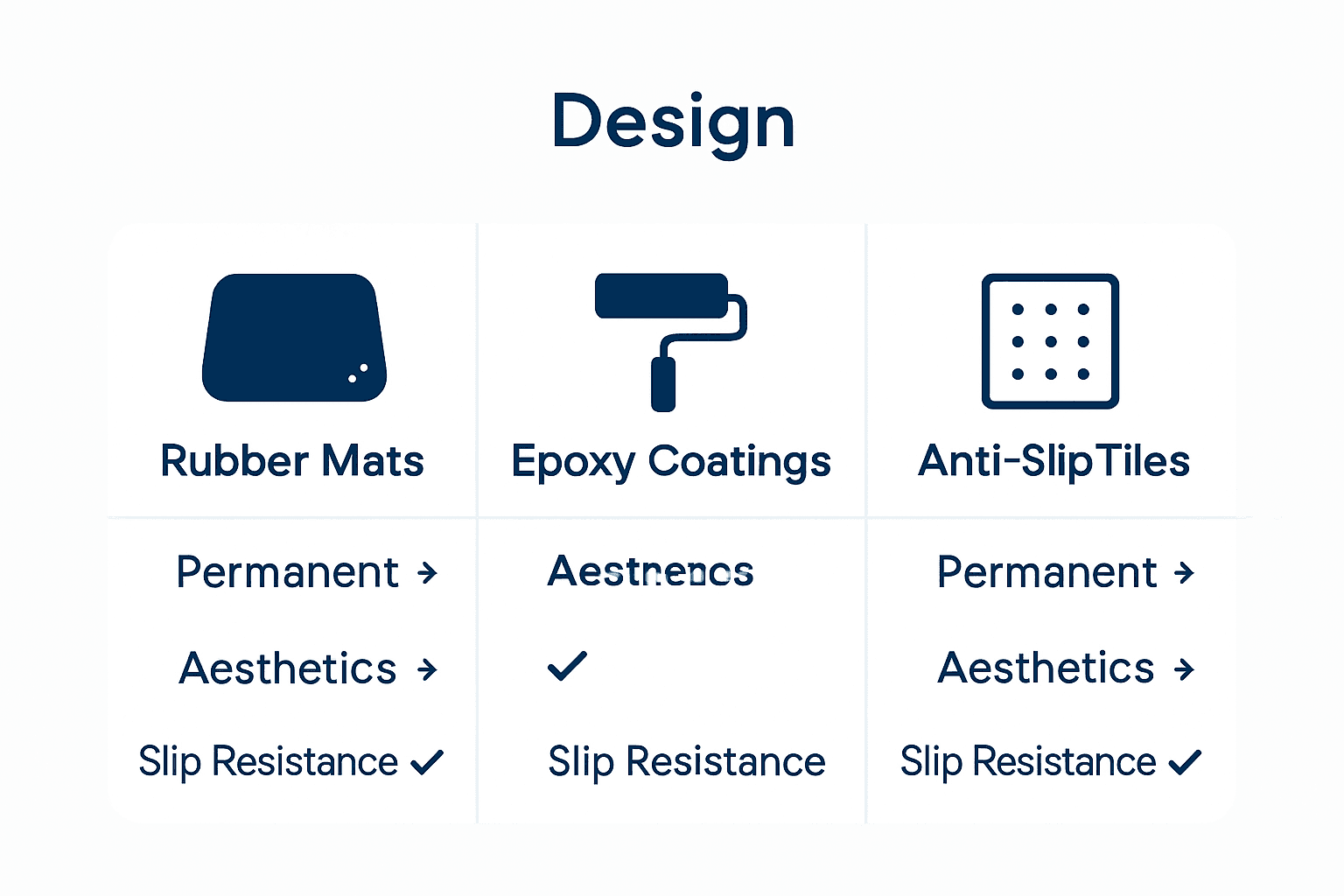
Anti-Slip Tiles Explained: Safety, Types, and Uses
Share
Did you know that slips and trips cause over a third of all workplace injuries in the UK? Preventing such accidents starts with choosing the right flooring. Anti-slip tiles have become a preferred solution for homes and businesses wanting to minimize risk while keeping spaces functional and attractive. By understanding what sets these tiles apart and how they perform in different environments, you can create safer floors without sacrificing style.
Table of Contents
- Defining Anti-Slip Tiles And Core Concepts
- Types Of Anti-Slip Tiles And Ratings
- How Anti-Slip Tiles Prevent Accidents
- UK Safety Standards And Legal Requirements
- Choosing, Installing, And Maintaining Anti-Slip Tiles
- Comparing Anti-Slip Tiles With Alternatives
Key Takeaways
| Point | Details |
|---|---|
| Importance of Anti-Slip Tiles | Anti-slip tiles are essential in high-risk environments, such as wet or heavily trafficked areas, to prevent slips and falls. |
| Tile Types and Their Uses | Different types of anti-slip tiles, including glazed, unglazed, and porcelain, offer specific advantages for various applications. |
| Safety Ratings | Understanding the Pendulum Test Value (PTV) is crucial for selecting tiles appropriate for their intended safety requirements. |
| Installation and Maintenance | Proper installation and tailored maintenance are vital for maintaining the safety features of anti-slip tiles over time. |
Defining Anti-Slip Tiles and Core Concepts
Anti-slip tiles are specialized flooring solutions engineered to provide superior traction and safety in environments where traditional surfaces might pose slip hazards. According to tiles.org.uk, these tiles are particularly crucial in wet or high-traffic areas where standard flooring could compromise personal safety.
Unglazed ceramic tiles represent a prominent category of anti-slip flooring, offering remarkable functionality across various settings. Tiles.org.uk highlights their versatility, noting they are especially suitable for environments like:
- Laundry rooms
- Utility spaces
- Bathrooms
- Playrooms
- Garages
The core characteristics of anti-slip tiles distinguish them from conventional flooring options. These specialized tiles typically feature textured surfaces, enhanced grip patterns, and materials specifically designed to reduce sliding risks. Their construction involves strategic surface treatments that increase friction, allowing individuals to maintain stable footing even in potentially slippery conditions. Our comprehensive anti-slip tile guide provides deeper insights into selecting the most appropriate tile for specific safety requirements.
Types of Anti-Slip Tiles and Ratings
The world of anti-slip tiles encompasses several distinct categories, each with unique characteristics designed to enhance safety and performance. According to tiles.org.uk, these tiles vary significantly in properties like porosity, density, and durability, making careful selection crucial for specific applications.
Tile Classifications include:
- Glazed Ceramic Tiles: Feature a decorative glazed surface over a porous body
- Unglazed Tiles: Commonly used in domestic and industrial settings
- Porcelain Tiles: Hardwearing with extremely low water absorbency and excellent anti-slip properties
BIID highlights a critical measurement for safety: the Pendulum Test Value (PTV). This standardized rating system categorizes slip potential into three key levels:
- High Risk: PTV 0-24
- Moderate Risk: PTV 25-35
- Low Risk: PTV 36+
When selecting anti-slip tiles for non-slip floor tiles like the J Rock Slate effect, understanding these classifications becomes essential for ensuring optimal safety in various environments.

Here is a comparison of key anti-slip tile types and their main features:
| Tile Type | Surface Finish | Water Absorbency | Common Application |
|---|---|---|---|
| Glazed Ceramic | Decorative, smooth | Medium to high | Bathroom walls Kitchen splashbacks |
| Unglazed Ceramic | Textured, matte | Medium | Bathrooms Garages Utility rooms |
| Porcelain | Matt, textured | Very low | High-traffic Wet areas Commercial spaces |
How Anti-Slip Tiles Prevent Accidents
Accidents caused by slips and falls represent a significant safety concern in both residential and commercial environments. The strategic design of anti-slip tiles plays a crucial role in mitigating these risks by creating surfaces that dramatically reduce the potential for unexpected sliding and falling.
The primary mechanism of accident prevention lies in the unique surface texture of these tiles. By incorporating specialized grip patterns and microscopic irregularities, anti-slip tiles increase friction between footwear and the floor surface. These engineered features create multiple contact points that interrupt smooth sliding, effectively anchoring an individual’s movement.
The Health and Safety Executive emphasizes the importance of understanding slip resistance, drawing parallels to safety standards in footwear. Just as safety shoes are rated for their coefficient of friction, anti-slip tiles are designed with similar scientific precision to minimize accident risks.
When selecting anti-slip solutions, it’s critical to consider specific environmental conditions. Different areas require different levels of slip resistance, which is why manufacturers like Vivido Tiles offer specialized tiles with varying grip ratings to address unique spatial requirements. Whether it’s a wet bathroom, a busy kitchen, or an industrial workspace, the right anti-slip tile can be a fundamental barrier against potential injuries.
UK Safety Standards and Legal Requirements
Navigating the complex landscape of ceramic tile regulations requires a comprehensive understanding of UK legal frameworks and safety standards. UK Government guidelines provide intricate classifications for ceramic tiles, recognizing that different tile types serve unique purposes and require specific regulatory approaches.
Key Tile Classifications include:
- Refractory tiles
- Support or filler tiles
- Roofing tiles
- Specialized purpose tiles
- Ornamental tiles
Beyond classification, the UK maintains strategic measures to protect domestic manufacturing and ensure product quality. Government sources highlight ongoing anti-dumping regulations specifically targeting ceramic tiles, particularly those with surface areas less than or equal to 3600cm² and no tile edge exceeding 600mm in length.
For manufacturers and consumers of anti-slip floor tiles, understanding these regulatory nuances is crucial. These standards not only protect market integrity but also ensure that safety, quality, and performance requirements are consistently met across different tile applications and environments.
Choosing, Installing, and Maintaining Anti-Slip Tiles
Tile selection requires careful consideration of environment and specific performance requirements. Tiles.org.uk emphasizes that different tile types serve distinct purposes, with each category offering unique advantages for various applications.
Choosing the Right Tile:
- Glazed Tiles: Best for wall applications in bathrooms and kitchens
- Unglazed Tiles: Ideal for high-traffic and wet areas
- Porcelain Tiles: Hardwearing with low water absorption
Research from tiles.org.uk reveals an important maintenance insight: more slip-resistant tiles can be more challenging to clean. The slip-resistant profiles vary for bare feet and shoes, requiring tailored cleaning approaches to maintain their safety features.
When installing anti-slip tiles, precision is key. Professional installation ensures optimal performance, with careful attention to grout lines, surface preparation, and appropriate adhesive selection. For those looking to tile their bathroom, understanding these nuanced requirements can make the difference between a safe, long-lasting surface and a potential safety hazard.
Comparing Anti-Slip Tiles with Alternatives
Safety flooring encompasses a range of solutions, but anti-slip tiles stand out for their comprehensive protection and design versatility. Unlike alternative options like rubber mats, epoxy coatings, or traditional smooth tiles, anti-slip tiles offer a permanent, aesthetically pleasing solution to reducing slip risks.
When evaluating slip resistance, The Health and Safety Executive emphasizes the critical importance of measuring coefficient of friction (CoF). This scientific approach to assessing slip potential applies not just to footwear, but directly translates to flooring solutions. Anti-slip tiles are engineered to maintain consistent friction levels across various conditions, unlike temporary solutions that degrade quickly.
Alternative Flooring Comparison:
- Rubber Mats: Temporary, prone to displacement
- Epoxy Coatings: Can wear down, less aesthetic
- Smooth Ceramic Tiles: Minimal slip resistance
- Anti-Slip Tiles: Permanent, design-flexible, consistent safety
For those seeking a balance between safety and style, exploring different tile finishes becomes crucial. Anti-slip tiles offer the unique advantage of combining safety features with design flexibility, making them superior to many traditional flooring alternatives.

Enhance Safety with Stylish Anti-Slip Tiles from Vivido Tiles
Protecting your home or business from slip hazards is vital. Choosing the right anti-slip tile means understanding key factors like Pendulum Test Value and surface texture to reduce accidents effectively. At Vivido Tiles, we offer a wide selection of premium anti-slip tiles with technical reliability and lasting grip. Our range includes durable porcelain and unglazed options designed to meet rigorous UK safety standards while enhancing your space’s aesthetic.

Discover how easy it is to upgrade your floors with safety and style by browsing our extensive collection of anti-slip floor tiles. Act now to benefit from expert advice, competitive prices, and free UK delivery at Vivido Tiles. Protect your loved ones or customers by choosing tiles that deliver confidence with every step.
Frequently Asked Questions
What are anti-slip tiles?
Anti-slip tiles are specialized flooring solutions designed to provide enhanced traction and safety, particularly in wet or high-traffic areas.
What types of anti-slip tiles are available?
The main types of anti-slip tiles include unglazed ceramic tiles, glazed ceramic tiles, and porcelain tiles, each offering unique properties suitable for different applications.
How do anti-slip tiles prevent slips and falls?
Anti-slip tiles feature textured surfaces and specialized grip patterns that increase friction between the tile and footwear, reducing the risk of slips and falls in potentially hazardous environments.
What factors should I consider when choosing anti-slip tiles?
When selecting anti-slip tiles, consider the environment where they will be installed, the required level of slip resistance (measured by Pendulum Test Value), and the maintenance needs, as some slip-resistant tiles may be harder to clean.